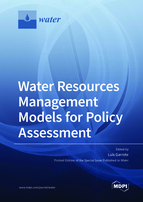Water Resources Management Models for Policy Assessment
A special issue of Water (ISSN 2073-4441). This special issue belongs to the section "Water Resources Management, Policy and Governance".
Deadline for manuscript submissions: closed (31 October 2020) | Viewed by 64227
Special Issue Editor
Interests: hydrodynamic modeling; water resources; hydrology; vulnerability; climate change; quantitative assessment
Special Issues, Collections and Topics in MDPI journals
Special Issue Information
Dear Colleagues,
Water resources management models support a variety of research applications, including the assessment of water availability, the allocation of water among competing uses, the evaluation of system performance, the identification of optimal system expansion, and the definition of suitable operating strategies. System analysis tools, like simulation and optimization, have been enriched with novel modelling concepts drawn from social sciences, economic analysis, conflict resolution, agent-based systems, and game theory, among others. The field has evolved from a traditional emphasis on cost–benefit analysis in water resource project investments to a wider scope that includes environmental implications, stakeholder concerns, social welfare, and human dimensions. We face now the challenge of developing integrated modelling frameworks to provide quantitative evidence for policymakers on water management issues.
This Special Issue of Water calls for original research papers that develop or apply water resources management models for policy identification and assessment. Open challenges in water resources management models include quantifying the response of water systems to policy interventions; addressing the nexus between water, energy, food, and the environment; characterizing the role of uncertainty in decision making, formalizing social interactions, or improving the theoretical understanding of complex adaptive systems. We seek contributions that address these and other challenges with a focus on policy assessment from local, regional, or global perspectives.
Prof. Dr. Luis Garrote
Guest Editor
Manuscript Submission Information
Manuscripts should be submitted online at www.mdpi.com by registering and logging in to this website. Once you are registered, click here to go to the submission form. Manuscripts can be submitted until the deadline. All submissions that pass pre-check are peer-reviewed. Accepted papers will be published continuously in the journal (as soon as accepted) and will be listed together on the special issue website. Research articles, review articles as well as short communications are invited. For planned papers, a title and short abstract (about 100 words) can be sent to the Editorial Office for announcement on this website.
Submitted manuscripts should not have been published previously, nor be under consideration for publication elsewhere (except conference proceedings papers). All manuscripts are thoroughly refereed through a single-blind peer-review process. A guide for authors and other relevant information for submission of manuscripts is available on the Instructions for Authors page. Water is an international peer-reviewed open access semimonthly journal published by MDPI.
Please visit the Instructions for Authors page before submitting a manuscript. The Article Processing Charge (APC) for publication in this open access journal is 2600 CHF (Swiss Francs). Submitted papers should be well formatted and use good English. Authors may use MDPI's English editing service prior to publication or during author revisions.
Keywords
- Water resources system models
- Policy
- Integrated water management
- Uncertainty
- Integrated assessment
- Conflict resolution






